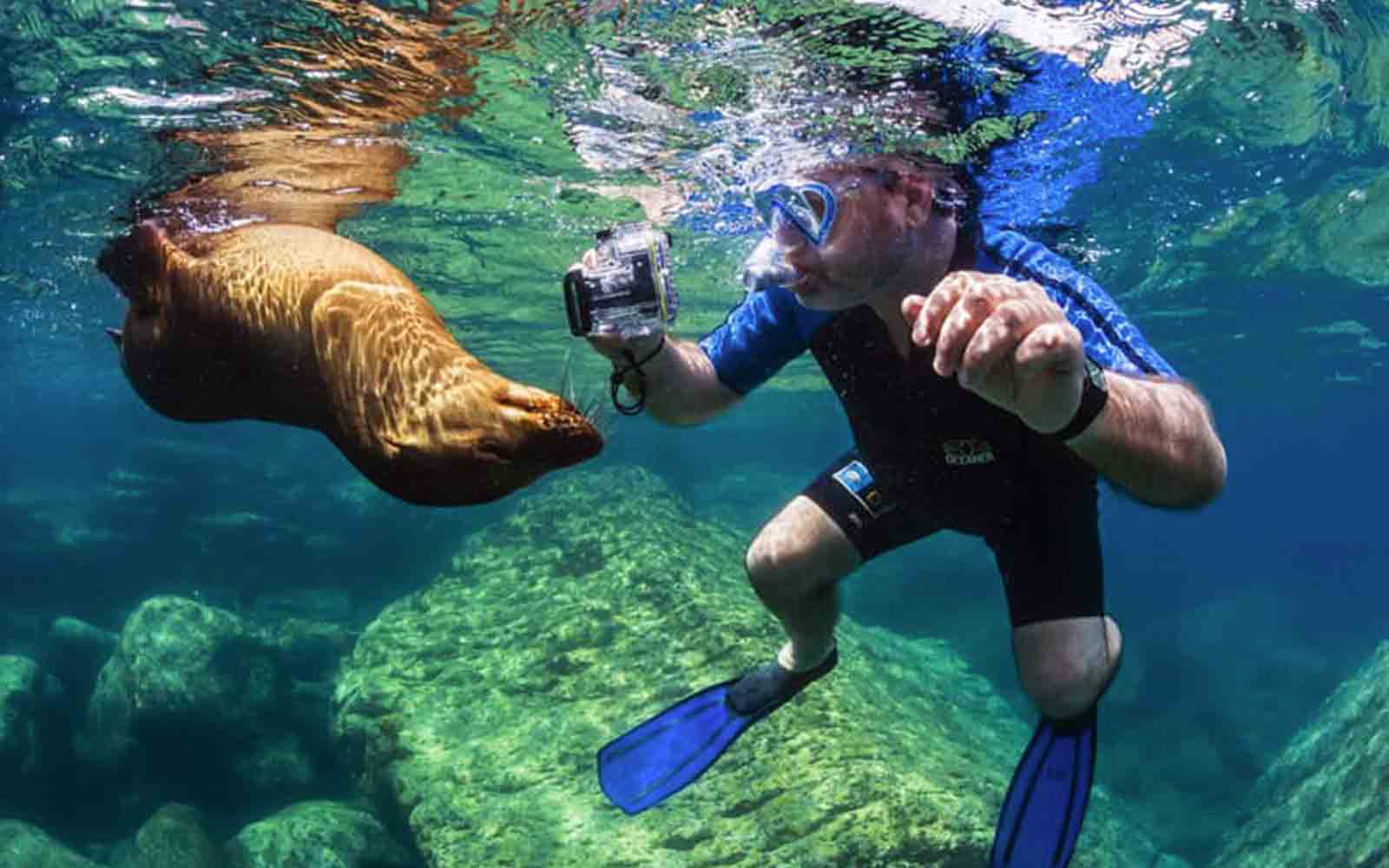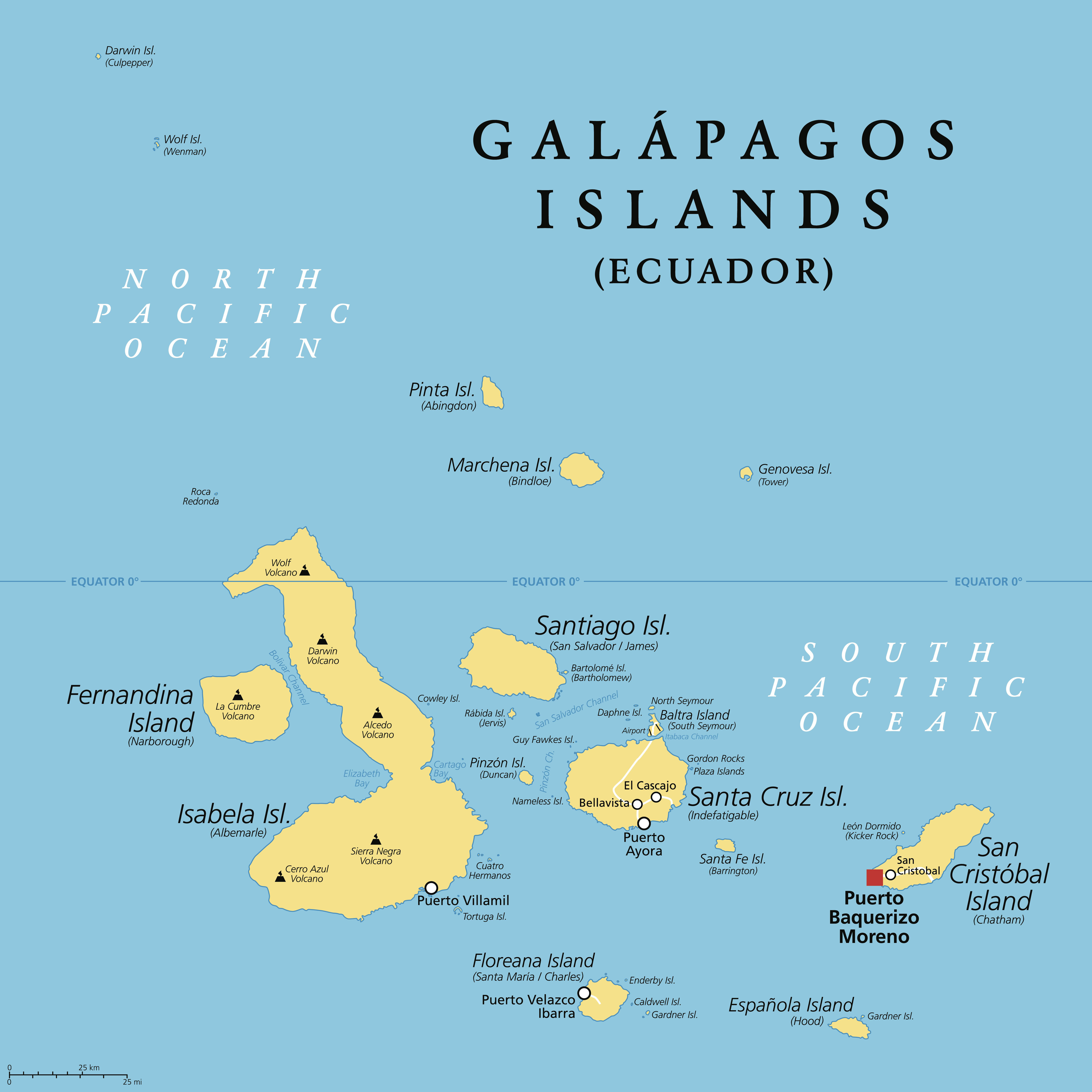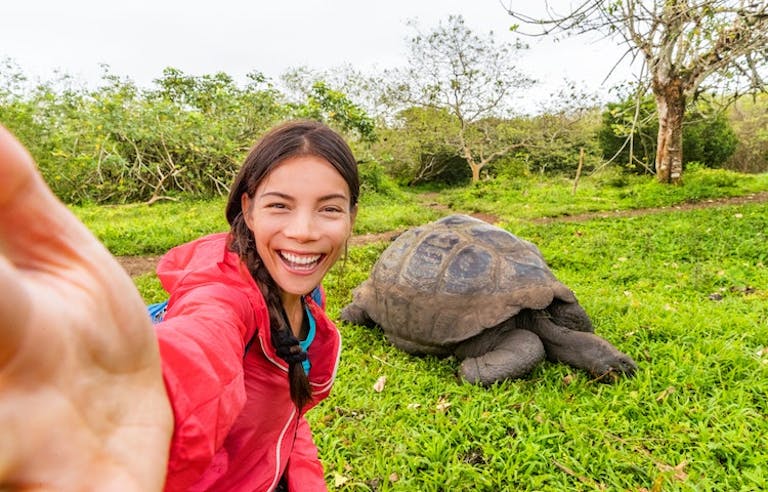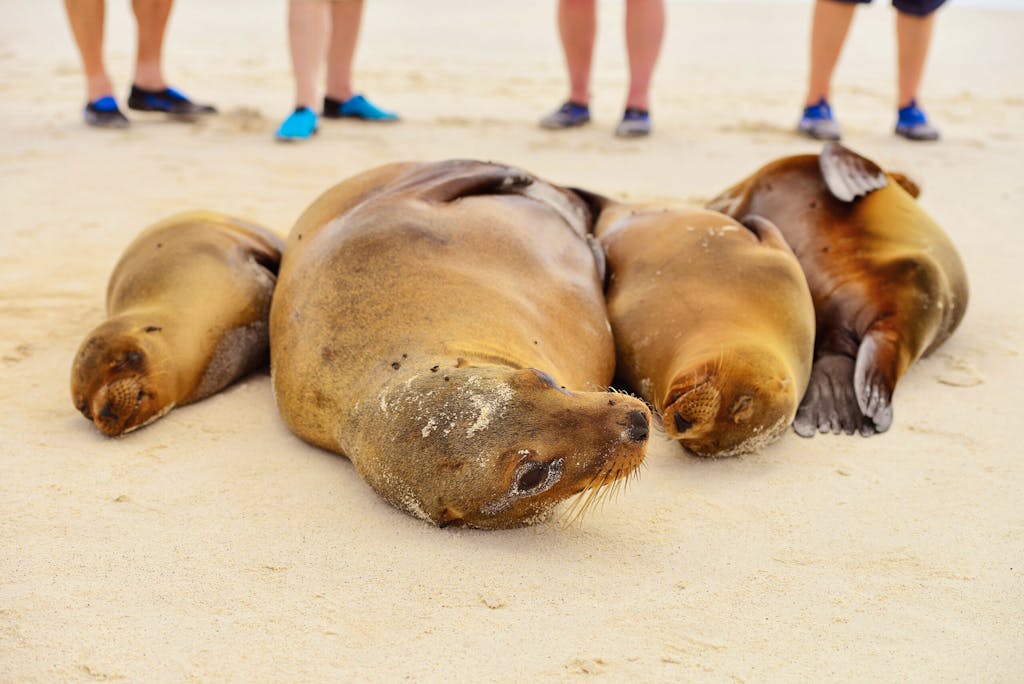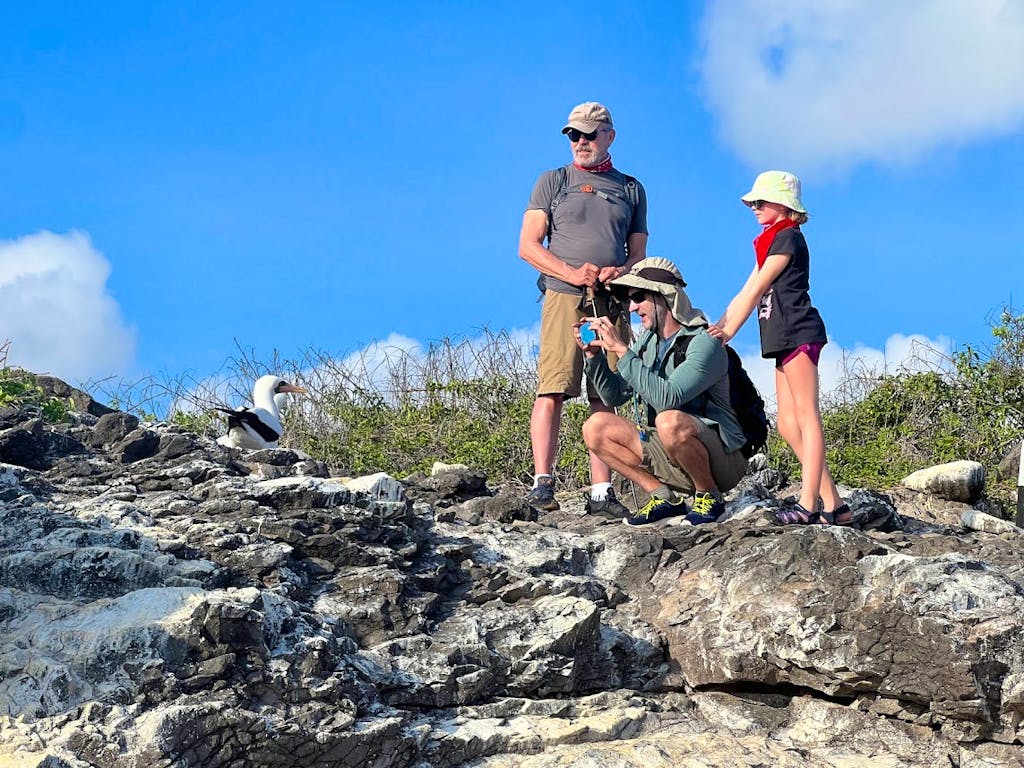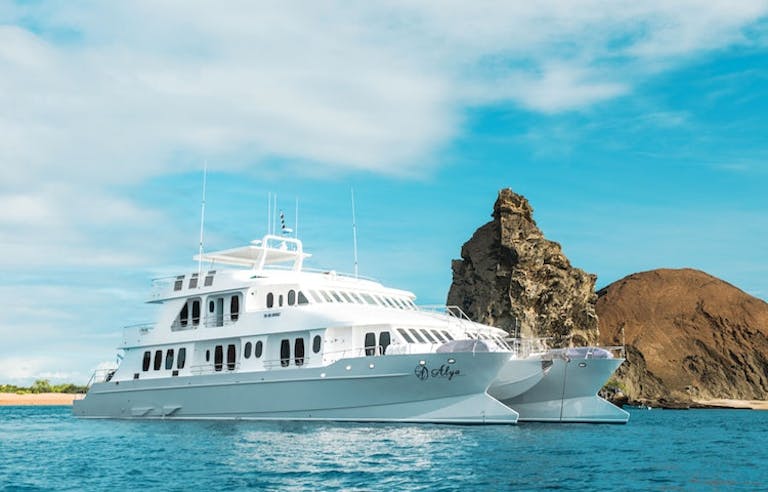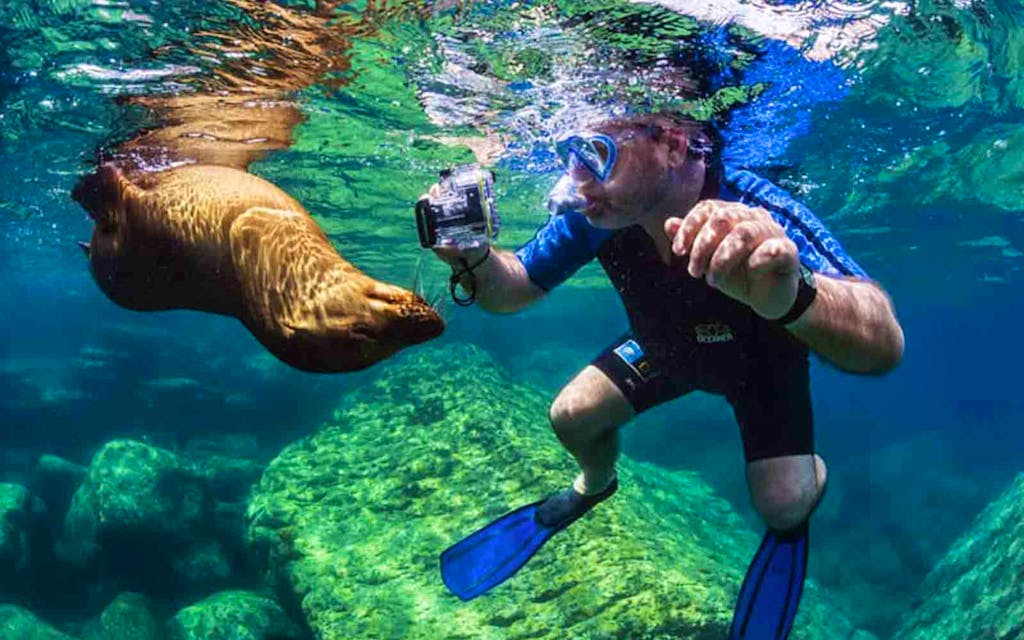Discover the Galápagos
From stunning beaches and volcanoes to an array of fantastic wildlife, the Galápagos Islands are an excellent travel destination for nature lovers and adventure travelers. Located approximately 600 miles off the coast of Ecuador, the 21 islands that make up the Galápagos are an equatorial archipelago formed eight million years ago by a volcanic hot spot in the Pacific Ocean. The Galápagos includes 18 major islands and many rocky islets, with the eastern islands having more vegetation (being the oldest in the region), while the western islands tend to be rocky and bare. The best way to see as many islands as possible is via cruise or small boat, which will allow for marine animal and wildlife viewing.
Thanks to the islands’ remote locations, endemic wildlife has evolved in isolation for eons—creating what Charles Darwin called “a little world within itself.” The flourishing natural wonders of this UNESCO Biosphere Reserve continue to make it the perfect destination for wildlife enthusiasts of all ages. To help preserve and protect this pristine environment, 95% of the Galápagos is a designated national park encompassing over 3,000 square miles.
The main islands are Isabela, Baltra, Floreana, San Cristóbal, and Santa Cruz, also the region’s only populated islands. Santa Cruz island is known for its white sand beaches, endangered giant tortoises (which can live for over 150 years!), sea turtles, and marine iguanas. The island’s main town of Puerto Ayora is home to the Charles Darwin Research Station and a few shops and restaurants catering to visitors. San Cristobal island is a series of extinct volcanoes that have joined together over time, and where travelers can find blue-footed boobies, sea lions, a cratered freshwater lake, and an excellent hiking trail that leads to the top of Tijeretas Hill. Floreana is the history island where you can find remnants of pirates, whalers, and early settlers. Isabela is the largest and one of the youngest islands in the Galápagos, formed by six shield volcanoes, of which five remain active — including Sierra Negra; see up to five species of giant tortoise, kaleidoscopic marine life, and incredible bird life such as penguins, hawks, flamingoes, and boobies; the waters around Isabela are especially productive, making it the best for spotting whales, dolphins, and many sea turtles.
Planning a trip to the Galápagos Islands? Read on to find out when, what islands to visit, what to do, and much more to make your vacation unforgettable.
What is the best time to visit the Galápagos?
The best time to visit the Galápagos Islands is anytime! Because the islands are situated on the equator, temperatures tend to be steady throughout the year, but slight seasonal differences exist. Regardless of the month or season you choose, wildlife activity abounds throughout the year, with opportunities to see plenty of native animals, marine creatures, and natural fauna.
While the Galápagos Islands are an amazing year-round adventure destination, there are two main seasons created by shifting ocean currents. The warm/wet season runs from January to June, bringing short, sporadic rain showers (often less than 10 inches a year in the lowlands) and air temperatures in the 80s–90s °F. The waters are generally calm, clear, and mid to high 70s °F. For those looking for snorkeling or other water adventures like swimming with green sea turtles, this is the ideal season to visit. Breeding season happens at the end of this wetter period, so travelers can also expect to see mating rituals of some of the islands’ birds. This is also when green sea turtles lay their eggs on the beach (January), with hatchlings in April.
The cool/dry season runs from June to December, bringing mist and fog (but very little precipitation) and lower daytime air temperatures in the 70s °F. This season is often called the Garua (“drizzly”) season. The waters can go as low as the mid-60s °F but are generally in the lower 70s °F and tend to be choppy because of seasonal trade winds. This is the season for watching out for marine life, especially sea lions (and their just-born pups), dolphins, whales, and giant tortoises returning to the Santa Cruz highlands.
For those who want less crowds but are still keen on seeing as much as possible, consider traveling during the shoulder season: April, May, September, and October.
The Galápagos Islands is one of those destinations many of us have on our bucket lists, and spotting wildlife is one of the main reasons to visit. To see the complete list of wildlife sightings each season, check out our articles 5 Interesting Facts About the Galápagos Islands and Best Time to Visit the Galápagos Islands.
What is the best way to get to the Galápagos?
The Galápagos Islands are a two- to three-hour flight from mainland Ecuador, depending on the route. Most flights depart from Quito’s Mariscal Sucre International Airport or Guayaquil’s José Joaquín de Olmedo International Airport. Flights land at San Cristobol Airport on Santa Cruz or Seymour Airport on Baltra, where you can connect with your guide, hotel, or ship.
How to get around the Galápagos?
The best way to get around in the Galápagos is with a multi-day cruise aboard a small yacht or catamaran, in the company of an expert crew and naturalist guides. Small inflatable motorboats, called pangas, are often used to get from the vessel to the shore, and there are plentiful opportunities to snorkel, kayak, and swim in pristine waters. A cruise-based experience in the Galapagos tends to be a much richer wildlife experience, because of the ability to call at multiple different islands and truly appreciate how varied the flora and fauna are on each, and get a firsthand glimpse at what interested Darwin and led to his theory of evolution. And cruises are of course the only way to visit the more remote islands, which are home to species that are not possible to see on a land-based trip – including red-footed boobies on Genovesa, flightless cormorants on Fernandina, and waved albatross on Española. Snorkeling opportunities are also much richer on a cruise-based itinerary, and you’re likely to encounter a lot fewer people during most shore excursions on a cruise, due to the way that permits are strictly limited for sites on the more remote islands. If you book with MT Sobek, we use a collection of deluxe yachts and catamarans, the smallest available in the Galápagos with up to 16 passengers.
We recommend a land-based trip for those who are especially sensitive to seasickness, or who want very specific dates that aren’t available on a cruise-based option, or for those who want more flexibility to tailor their activities or include beachtime. Those who prefer a hotel/lodge-based trip in the Galápagos can take advantage of inter-island ferries that run between Santa Cruz and San Cristóbal, and between Santa Cruz and Isabela. There are also day-boat options to nearby small islands and snorkeling spots. Small-seater planes are another option for time-strapped travelers who want to island-hop, although they only fly to some islands and are the pricier option. Car rental places or private drivers are available on populated islands, although roads are often rough. Public transportation is available on the populated islands, and bikes can be rented for exploration. Often, walking is your best bet in the touristed areas.
Do I need a visa to visit the Galápagos?
No visa is required for US citizens staying less than 90 days in any 12-month period.
How many days should I spend in the Galápagos?
The Galápagos is a vast destination, and you will enjoy it most if you plan on at least 7 to 10 days. For an ultimate bucket-list Galápagos tour, we recommend 11 days. This will allow you time to appreciate the abundance of trails, explore snorkeling spots, and visit remote harbors. Depending on the season, you will also have more opportunities to spot wildlife and observe mating rituals.
What are the top 4 places to visit in the Galápagos?
1. Isabela
The largest and one of the youngest islands in the Galápagos, formed by six shield volcanoes, of which five remain actives — including Sierra Negra. See up to five species of giant tortoise, kaleidoscopic marine life, and incredible bird life such as penguins, hawks, flamingoes, and boobies; the waters around Isabela are especially productive, making it the best for spotting whales, dolphins, and many sea turtles.
2. Fernandina
One of the most popular islands on traveler’ itineraries, Fernandina has a rocky landscape covered in petrified volcanic rock. It is also home to lava lizards, sea lions, Galápagos hawks, penguins, and the largest colony of marine iguanas in the archipelago. The island also hosts the flightless cormorant, an endemic bird species that has lost the ability to fly.
3. Santiago
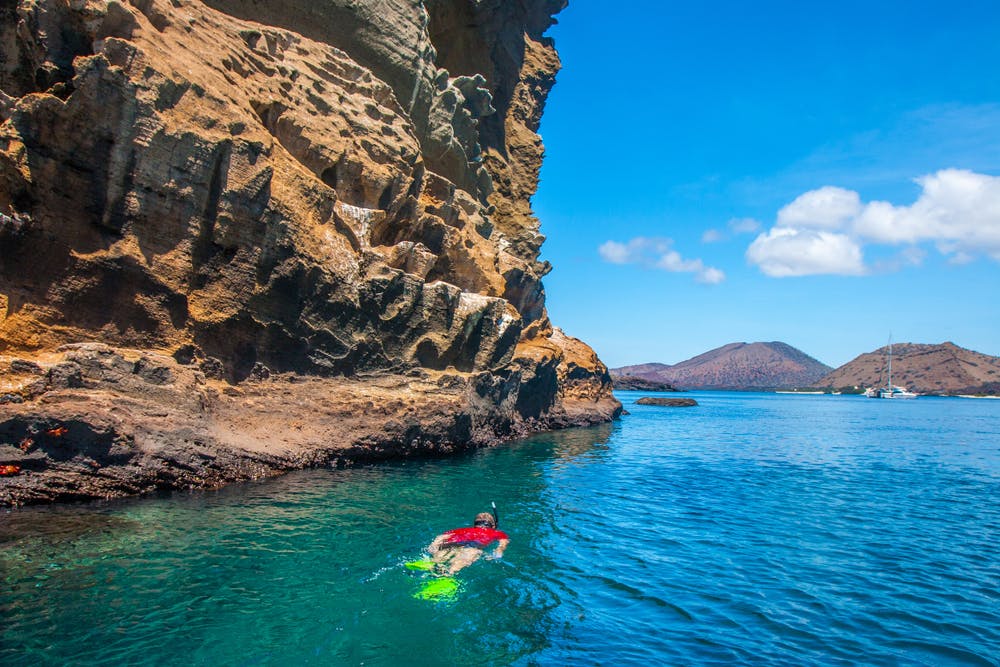
Formed by the joining of two overlapping volcanoes, this unpopulated island is famous for its black-sand beaches, sea lion colonies, white-tipped sharks, and various bird species, including different types of hunting herons. But the stunning volcanic lava formations and basaltic lava flows that have formed over time truly set it apart from the other islands, providing a unique geological history of how the islands formed. Visitors are encouraged to walk on the ancient flow sites to explore the curls and twists of lava that have hardened over time, and to enjoy some of the archipelago’s best snorkeling in the waters off of Santiago’s satellite islet of Bartolomé.
4. Genovesa
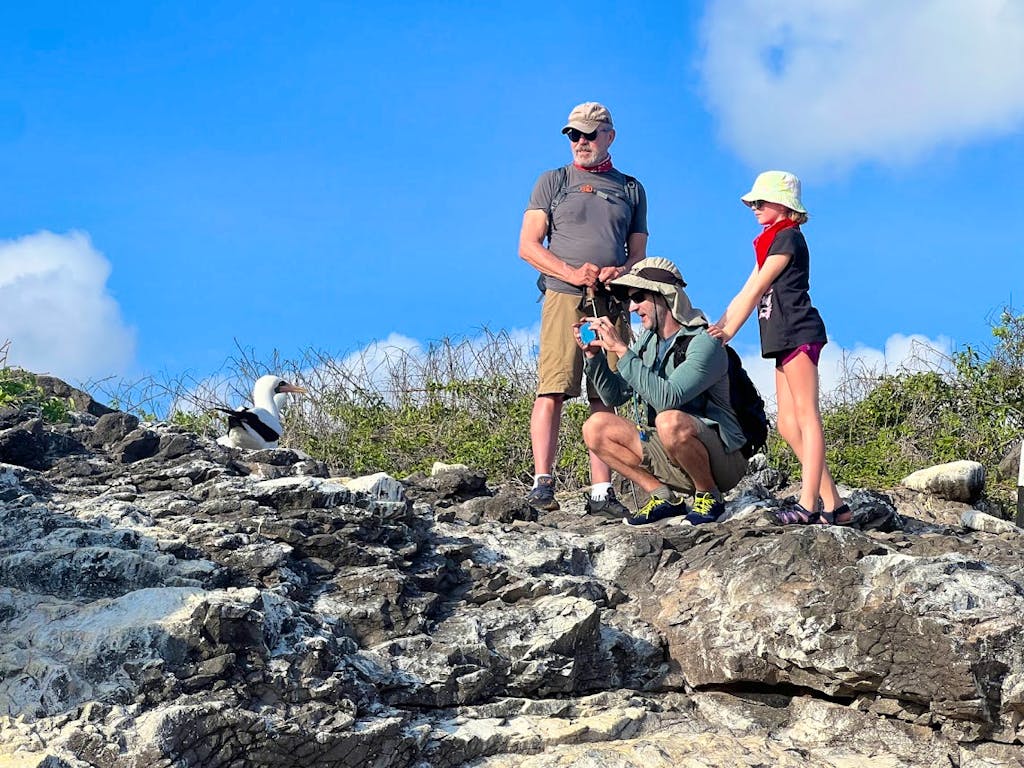
This arid, rocky island is a bird paradise with massive colonies of Nazca and (otherwise rarely sighted) red-footed boobies, frigate birds, and storm petrels; it’s also one of the few places to see short-eared owls during the day. Stretch your legs on a short hike up Prince Phillip’s Steps, a rock fall that forms a natural staircase up the cliffs, and snorkel in Darwin Bay, formed by the rim of a sunken crater.
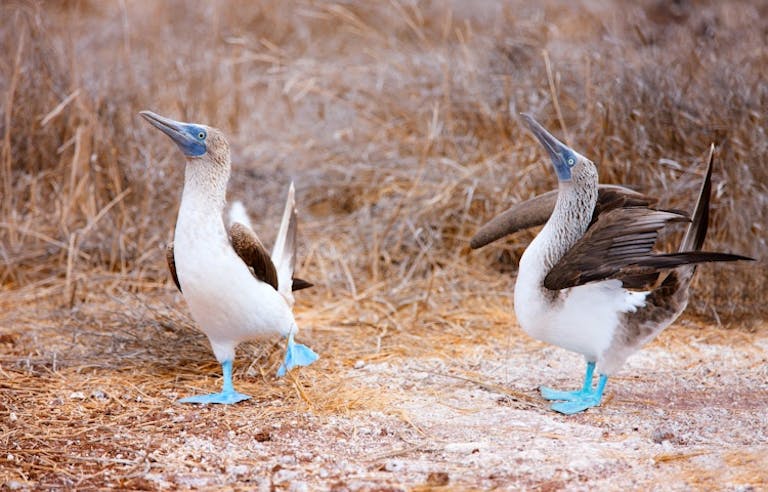
What are the best adventure tours in the Galápagos?
1. Ecuador Galápagos Adventure Cruise – Western Loop
Follow in the footsteps of Charles Darwin on this inspirational small-group adventure through the enchanted islands of the Galápagos. This classic Western Loop route takes in the natural wonders of the western islands of Isabela, Fernandina, Santiago, Sombrero Chino, and Rabida, as well as the central islands of Santa Cruz and North Seymour. The western islands are younger and more volcanically active, studded with cones, craters, a rippled lava landscape, and stunning beaches. Hiking, snorkeling, and kayaking under MT Sobek’s dedicated naturalist guide gets you amazingly close to the wildlife both underwater and on land. After each action-filled day, return to your intimate 16-passenger private yacht to rest and re-energize.
2. Ecuador Galápagos & Amazon Family Adventure
See two of the world’s most incredible and iconic wildlife destinations — the Amazon Rainforest and the Galápagos Islands — on this family trip featuring activities suited for ages 6 and up. From your Ecuadorian Amazon base at Sacha Lodge, look for monkeys, caimans, three-toed sloths, hundreds of species of birds, and blue morpho butterflies in the middle of a 5,000-acre nature preserve. Then, cruise for four nights in the Galápagos, where you’ll meet three-foot-long iguanas and 100-year-old tortoises, and snorkel alongside beautiful white-sand beaches under the watchful eye of sea lions.
3. Ecuador Galápagos Luxury Wildlife Adventure Cruise
Experience two incredible wildlife destinations — Ecuador’s Andean cloud forest and Galápagos Islands — in comfort and refinement on this small-group adventure. Discover UNESCO-listed Quito, then venture into the cloud forest for a stay at Kapari Lodge, located in the Chocó Andino biosphere reserve. Explore this biodiversity hotspot on trail walks through multiple ecosystems, and look out for toucans, tanagers, hummingbirds, as well as orchids, butterflies and bromeliads. Return to Quito and fly to the Galápagos, where you’ll cruise in style aboard the new 16-passenger luxury catamaran Alya, featuring private balconies! Hiking, snorkeling, and kayaking under the guidance of MT Sobek’s dedicated naturalist guide gets you amazingly close to the wildlife both underwater and on land. After each action-filled day, return to the luxury of your private catamaran to rest and re-energize.
This cruise follows a classic Western Loop route and takes in the natural wonders of Santa Cruz, Isabela, Fernandina, and Santiago islands.
4. Ecuador Galápagos Adventure Cruise – Eastern Loop
This classic, seven-night Eastern Loop route takes in the natural wonders of the eastern islands of Genovesa, San Cristobal, Española, and Santa Fe, the western island of Santiago, and the central islands of Floreana, Santa Cruz, and South Plaza. The eastern islands are geologically the oldest in the Galápagos, allowing more time for vegetation to take hold and flora to thrive in fertile volcanic soils. Hiking, snorkeling, and kayaking under the guidance of MT Sobek’s dedicated naturalist guide gets you amazingly close to the wildlife both underwater and on land, including red-footed boobies, stunning birdlife, the Galápagos penguins, sharks, turtles, and rays. After each action-filled day, return to your intimate 16-passenger private yacht to rest and re-energize.
5. Ecuador Galápagos Islands Private Adventure Tour
See another side of the Galápagos on this lodge-based adventure that combines the enchanting islands of Santa Cruz and Isabela. Follow expert naturalist guides to explore hidden spots where cruise passengers don’t go and experience the many landscapes of this nature-lover’s paradise. Each day brings a new excursion, including the fumaroles and caldera of Sierra Negra Volcano, snorkeling with Galápagos penguins and marine iguanas, and, of course, spotting the native wildlife for which these islands are known. Your trip begins and ends in historic Quito, the capital of Ecuador and a UNESCO World Heritage Site.
Where are the best places to stay in the Galápagos?
Accommodation in the Galápagos ranges from small yachts and catamarans to comfortable hotels and cruise boats. Small yachts and catamarans, up to 16 passengers, offer guests the rewards of being located close to stunning locations, gorgeous white sand, and pristine calm waters of the Galápagos.
MT Sobek offers tours aboard the Eco-Galaxy, Galaxy, the Alya, and the Endemic, where sun decks, dining areas, entertainment centers, snorkeling equipment plus kayaks, and rooms that range from twin-sized, queen to king beds. Other amenities include free Wi-Fi, some laundry service, public bathrooms, and A/C.
On Santa Cruz Island, we recommend the Angermeyer Waterfront Inn on the Punta Estrada waterfront in Puerto Ayora. This quiet inn is decorated with lava rocks and driftwood, has a restaurant and bar onsite, and has a balcony or terrace attached to every room. Enjoy comfortable guest rooms with ensuite bathrooms, full bar service, and excellent views of the bay.
On Isabela Island, we recommend Casa Marita in Puerto Villamil, a comfortable beachfront inn with incomparable views and access to one of the most beautiful white sand beaches in the Galápagos. Casa Marita sports the charm and atmosphere of a large country home, with 16 rooms that are individually decorated with fanciful flair. Guests are invited to share the comfortable lounge, library and bar areas.
Where are the best places to stay in Quito?
1. Swissotel-Quito, Ecuador – Luxury Hotel
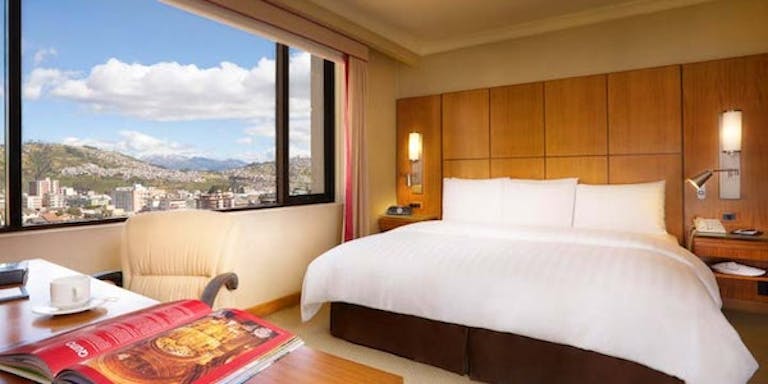
This upscale hotel gives you the complete luxury experiences, with generous amenities like elegant rooms featuring city or mountain views, flat-screen TVs with premium channels, complimentary Wi-Fi, four on-site restaurants, a fitness center, and an indoor pool. Unwind after a day’s hike or go on a walk to visit Quito’s Floresta neighborhood, which has access to great shopping, museums, and the city’s architectural gems.
2. Illa Experience Hotel, Quito, Ecuador – Luxury Hotel

Illa Experience is a deluxe new boutique hotel with just 10 rooms, housed in a restored colonial mansion in the historic San Marcos neighborhood of Quito’s Old Town. The family owners take great care in providing an immersive experience to capture the traditions, flavors, and scents of a local, traditional home, as well as chances to meet local artisans who make the neighborhood such a special place. The elegant contemporary rooms overlook the Old Town or quiet internal patios and feature unique design details drawn from family traditions. An award-winning gourmet restaurant and rooftop bar celebrate local ingredients and recipes, and the spa features a Jacuzzi, sauna, and small fitness center, with massage treatments available.
Interesting Facts to Know About the Galápagos
- The Galápagos were first discovered in the 16th century, but it wasn’t until 1934 that the first tourists arrived by boat. In 2022, almost 270,000 people traveled to the Galápagos Islands, with nearly half being Ecuadorian nationals.
- The Ecuadorian government designated 95% of the Galápagos Islands a national park in 1959 to commemorate the 100th anniversary of Charles Darwin’s On the Origin of Species.
- The islands formed from ancient volcanoes, and the region is still active – new islands are always forming.
- The islands sit on the Northern and Southern Hemispheres and are situated in the Pacific Ocean, where three ocean currents meet.
- The Galápagos host almost 9,000 native species, including the Giant tortoise and three types of boobies—the blue-footed booby, the red-footed booby, and the masked booby. The largest tortoise ever recorded on the islands weighed over 900 lbs. (he was aptly named “Goliath”).
- MT Sobek was the second US company to begin trips to the islands in 1970—we have 50 decades of experience to offer! Indeed, as the original adventure travel company, we provide MT Sobek guides, experienced naturalists with local expertise and trekking experience.
What is the language in the Galápagos?
The official language spoken in Ecuador and the Galápagos Islands is Spanish. MT Sobek works with local multi-lingual guides who speak Spanish and English fluently.
What to eat in the Galápagos?
Visitors to the islands should expect many seafood options, such as lobster cooked in coconut milk, seafood rice (rice mixed with mussels, shrimp, and vegetables), and ceviche made with mollusks, shrimp, or freshly caught fish. Another popular dish is encebollado, a pickled onion and tuna stew. For those who need a break from seafood, slow-cooked meat called seco is also widely available and is made with beef, chicken, goat, or lamb. Expect lots of tropical fruits and banana-like plantains.
Locals like to drink fresh fruit juices and shakes, pilsner beer, and firewater (a spirit known locally as aguardiente), named because of the burning sensation it can leave in your mouth and throat. The more fulfilling colada de avena con naranjilla is a drink made with oatmeal, naranjilla fruit water, and sugar and is usually served at breakfast.
What is the currency in the Galápagos?
Ecuador’s currency is USD. We recommend that travelers bring plenty of cash on hand as it’s the only currency drivers accept. Credit cards are another option, but not all service providers accept them, and avoid travelers’ checks as they are not accepted. Cash is your best bet if you are unsure what to bring.
What is the electricity in the Galápagos?
Electricity in Ecuador is 100v AC, 60Hz, and plugs are the two-pin variety. This is the same voltage and plug type used in the US, so you won’t need an adapter for your electronic devices. A good resource to see images of plug types is www.power-plugs-sockets.com.
What is the time zone in the Galápagos?
The Galápagos Islands and Ecuador operate on the UTC time zone (Coordinated Universal Time). For US comparisons, though, Ecuador is aligned with US Eastern Standard Time (EST) while the Galápagos is on Central Standard Time (CST).
What to wear in the Galápagos?
For exploring the Galápagos Islands, you will need to wear comfortable hiking clothes that dry quickly. We recommend you bring lightweight hiking boots or sturdy sneakers with good traction and ankle support, plus sturdy sandals or water shoes such as Keens, Teva, or Chaco—ideally with heel strap and toe protection. Hikes aren’t long but most are over rocky, uneven terrain that may be sandy, rocky, or hardened lava. Sandals or water shoes are needed for wet landings when the pangas, or small motorboats, land on beaches and you wade through a few inches of water to shore.
If you plan on kayaking or snorkeling, wetsuits are essential. Upon arrival in the Galápagos, guests are taken to dive shops in town, where you can rent a wetsuit for the week as they are not provided by most tour providers. A price of a wetsuit ranges between US$35 (for the shorties) and US$45 (for the longer ones). An optimal suit is 2-3mm thick and short- or long-legged are both fine; a good wet suit should fit like a second skin. If you are renting wetsuits, be sure to return them at the end of your trip prior to leaving the Galápagos islands.
Recreational equipment like binoculars, trekking poles, reef-friendly sunscreen, and lip protection are handy to bring. If you are prone to seasickness, consider motion sickness preventives for a comfortable time cruising around the Galápagos Islands.
With a little preparation, you can look forward to a fun, inspirational trip to the Galápagos Islands!
